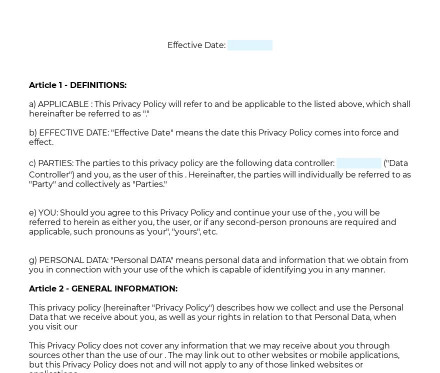Privacy Policy For Website Or Mobile App Free
Most of the Websites or Mobile Apps set out the terms of how they treat the information they collect from the users. In these cases, a Privacy Policy document can be used.


 Template Overview
Template Overview
Most of the Websites or Mobile Apps set out the terms of how they treat the information they collect from the users. In these cases, a Privacy Policy document can be used. It is considered as an agreement, as users manifest their assent by continuing to use the website/app. Although, the document only explains the users, in "non-legal" terms, what happens with the collected information. In the United States, it is required by law to fill out the Privacy Policies, and it shows how these kinds of documents explaining about the privacy and collected data are.
One of the primary functions of a Privacy Policy document is to let the user know exactly how information is collected from them, whether that is an active collection (like asking the user-specific questions) or passive collection (like through the use of cookies). If the user goes in knowing what to expect, it is less likely that there will be problems between the user and the website/app down the road.
Privacy Policies are available on almost all major websites and apps today, and the operator should ensure a great one is in place for the business. This Privacy Policy is primarily for use in the United States but is also compliant with the EU's General Data Protection Regulation, or GDPR, for those businesses that handle and process the personal data of EU citizens.
You fill out a form. The document is created before your eyes as you respond to the questions.
At the end, you receive it in Word and PDF formats. You can modify it and reuse it.
 How to use this template
How to use this template
This Privacy Policy outlines how information is collected, how it is stored, and how it is used, among other things.
In the document, the operator will be able to outline the following information:
- what personal data is taken from users, actively
- what personal data is taken from users, passively
- how the data is stored
- how the data is used
- if data is shared with related entities
- if data is shared with third parties
- if cookies are used
- what the user's rights are concerning the data collected
- if children are allowed/encouraged to use the website/app
- how data collected from children is handled
- how users can contact the operator of the website or app if they have any concerns
It is critical to inform users about how their information will be managed. Often, a Privacy Policy will go hand in hand with a Terms and Conditions document (ideti linka).
 Applicable law
Applicable law
No laws outline what must be put into the Privacy Policy for websites/apps. Although, websites disclosures are broadly governed under U.S. Common Law and the advertising and privacy laws of the Federal Trade Commission. This Privacy Policy is also compliant with the EU's General Data Protection Regulation, or GDPR, for those companies which may process the data of EU citizens.
Specific other Federal laws are applicable as well, including The Children's Internet Protection Act of 2001 and The Computer Fraud and Abuse Act of 1986.
Ready to build your document from this template?


 Please wait
Please wait
